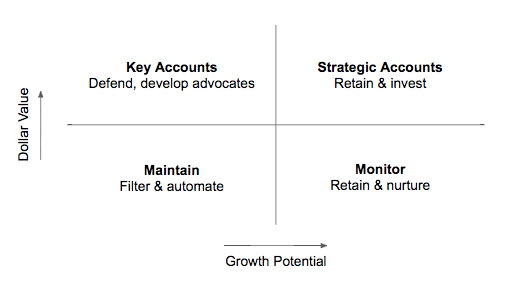
Customer portfolio segmentation strategy is usually determined by size of account, industry vertical, product package purchased, or a combination of these and other factors.
While this defines the company’s customer engagement strategy at a macro-segmentation level, it’s also important for CSMs to think about their own portfolios as a book of business that also needs to be segmented. This will help them determine where best to invest time and energy into each customer.
Consider the following segmentation model:

Customers on the right side of the quadrant, Strategic and Monitor accounts, will be the source of most portfolio revenue expansion. Key accounts will are cash cows buffeting the recurring revenue base against more volatile segments. Also leverage key accounts for references and advocacy in the marketplace.
We should minimize efforts on low dollar, low growth accounts in the Maintain segment.
As SaaS companies grow segmentation naturally happens at the team level, but portfolio-level segmentation can help CSMs protect their most precious resource, their time.

I've spent my career working in technology companies to build customer-centric teams, processes and technology platforms. In 2017, I founded Customer Imperative, a consulting firm that helps fast-growing B2B SaaS companies improve renewals, increase expansion sales and scale customer engagement. See full bio ›